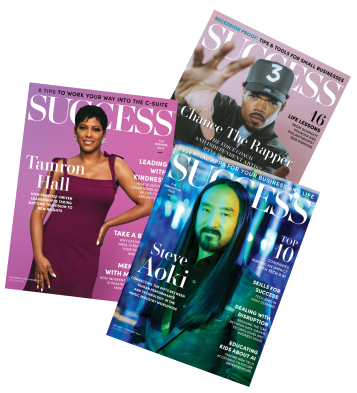Consider what life would be if we only did what we know, what we were already good at or what we currently liked. We would never grow.
It’s no wonder babies cry when they are pushed from the safe and nurturing confines of their mothers’ womb and into the brightly lit, cold confines of the world. And yet, despite all of our experience at adapting and stretching ourselves in one way or another, it can still be hard to be comfortable with being uncomfortable.
Learning happens outside of the familiar and comfortable. This likely isn’t news for experienced entrepreneurs, who have learned the hard way that trying, failing, changing directions and trying again is often the road to success. But is there such a thing as venturing too far from the known? At what point is learning replaced with simply inducing fear or anxiety just to say you did?
Imagine a person who is generally afraid of heights, but still willing to ride roller coasters. The key is to have a full understanding and trust of the safety measures in place and a learned expectation of their own physiological response. In other words, they know their limits and prepare for the times when they are willing to push those limits.
To set aside the analogy of the person afraid of heights, taking a risk isn’t always about facing your greatest fear. Maybe your version is dining alone at a new restaurant or striking up a conversation with a stranger. Start small. The payoff isn’t as big, but neither is the risk.
Bestselling author Brené Brown begins each day with the mantra, “Today, I’m going to choose courage over comfort.” Choosing courage, in all its forms, challenges our preconceived notions and expands our comfort circle. As your comfort circle increases, so does your willingness to tackle bigger risks.
Becoming comfortable with being uncomfortable
Finding the sweet spot of comfort and discomfort requires preparation, honesty and, of course, some risk. Start by asking yourself the following questions:
- Have you done the work to ensure you’re prepared for this type of risk?
- Is it worth it? Taking a risk for the simple pleasure of overcoming a fear or insecurity is great. But is your time better spent on something more personally or professionally gratifying?
- Is this the best time to leave your comfort zone? If you’re in a tough financial spot, for example, now may not be the best time to launch a new business.
- Are there less risky options that would provide you some building blocks on which to expand your comfort circle?
- How will you respond to failure? Venturing too far from your comfort circle can drain your motivation to try again.
- Is there a trusted friend or colleague who can support you through this risk?
3 entrepreneurs’ on becoming comfortable with being uncomfortable
Next, check out the advice from three entrepreneurs who share their experiences with staying uncomfortable.
Cole Hernandez
Former founder of Pink Graffiti, a now-defunct brand storytelling agency
Some take one vitamin a day. I take one dare a day. A dare is a courageous action that’s packaged in play. It’s important for me to not allow fear to dictate my life. I choose play.
[Beginning in 2014, I helped] boutique hotels and travel companies with marketing and PR efforts. I was inspired to launch my business, Pink Graffiti, out of frustration. Many hotel owners focus only on profit. We all want to make money, but sometimes owners forget that customers don’t buy unless you’re solving their problem or fulfilling their desire. When a business stops caring about wooing its customer, everyone loses.
In late 2018, I launched The Daring Kind podcast. I wanted an outlet to speak to brave entrepreneurs, coaches and professionals who were living in alignment with their personal missions.
There’s no one-size-fits-all approach to becoming comfortable with being uncomfortable. If you are someone who struggles with anxiety, this might mean taking small incremental steps toward your personal mission through daily dares. I’m a recovering perfectionist, so I struggle with anxiety. This is my approach. For others, it might look more like leaps.
Either way, it’s important to remember to “do no harm” to yourself or others, and let your dares be guided by what feels energizing rather than depleting. The question I ask myself before I take any major leap is: “Would I regret it if I didn’t try?” If the answer is yes, you owe it to yourself to step into the journey. Not everything is going to work out. When you dare to take ownership of your life, you’ll never end up empty-handed. There’s always a lesson, an adventure, a friend or a new opportunity that will come from the energy you’ve created by being more daring.
Shyam K. Iyer
Founder of SKI Charities
I am a finance professional with a focus on international projects and emerging markets. My inspiration to launch SKI Charities in 2010 followed the Great Recession. The finance industry was rightly scrutinized at the time, but I knew finance could also be used to support and empower people in the most isolated parts of our world.
To build SKI Charities from scratch, I dipped into savings and raised small donations through our website. Through careful financial management and the pro bono work of attorneys and professionals who shared our vision, we survived the first year and have been building upon that foundation.
Although an entrepreneur may drive early success, I have found successful entrepreneurship to be far more bottom-up, as local level ownership and buy-in will determine the success of any project or enterprise. Autonomy and control must devolve from the entrepreneur to the field.
Making this shift in outlook was incredibly difficult for me, a type-A person. But with so many staff members and beneficiaries depending on me to get this balance right, I had no choice but to embrace this type of management.
Without having some knowledge of your temporary limits, there is always a chance of pushing yourself too far too fast. The entrepreneurial path is full of challenges and at its core is about a person’s appetite for being comfortable with being uncomfortable. To leave the stability of a day job, you must be ready with a professional network and prepared for the associated professional difficulties. But the most important factor is a very personal one: There comes a time when you are ready to take responsibility for making your ideas into a reality.
Rio Rocket
Artist, actor and entrepreneur
I could draw before I could read or write. I’d draw and sell my own comics to my family members. I began a career as a part-time graphic artist and web designer in the early stages of the modern internet. Through passion for my craft and delivering world-class service my career evolved and grew into a full-service commercial graphic art, web development and digital marketing service.
The landscape of career paths has been affected so much by technology. I’ve had to learn and relearn how to deliver the highest-quality products and services to my clients over and over again. This has made me realize that I must dedicate myself to becoming a lifelong student of my craft.
I got too comfortable as a visual artist. As with any entrepreneur who eventually reaches the summit and needs a bigger mountain to climb, I entered the acting arena as a voice artist, evolving into a film and TV actor, commercial model, motivational speaker and event host. I grew up saying I would likely never do those things. As my story unfolded, I discovered that I love the artistry behind storytelling with your voice and body even more than I do with visual art alone.
If you are fearful of change, eliminate all intellectualization of what will or won’t happen and take action immediately. Action helps you overcome fear and motion creates emotion. You are important. Think and believe that you are an important person with important goals. Believe and visualize yourself achieving those goals. Do this every single day. Be enthusiastic about your goals and never consider the thought of giving up. You owe it to your future self.
This article originally appeared in the November/December 2019 issue of SUCCESS magazine and was updated July 2023. Photo by FXQuadro/Shutterstock



